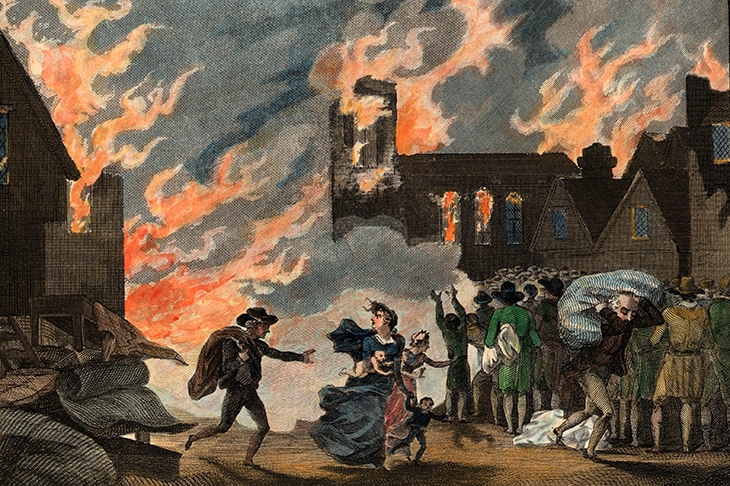Tragically, the current pandemic lends this sparkling study of London in its most decisive century a grim topicality — for the city, during the most explosively expansive phase in its growth, also experienced the arrival of two of the four horsemen of the Apocalypse — war and pestilence — riding in to wreak havoc on an unprecedented scale.
The 17th-century city may have narrowly escaped conquest and famine, but another Apocalyptic outrider — fire — also visited in 1666, leaving medieval London, with its filthy warren of narrow, timbered streets, in ashes. The upside, as Margarette Lincoln demonstrates, was that the cleansing inferno cleared the ground for London to become, as her subtitle claims, ‘the world’s greatest city’.
The story is often told in the words of those who witnessed both the disasters and the beginnings of the city’s subsequent resurrection. Refreshingly, Lincoln’s witnesses include not only the famous diarists Samuel Pepys and John Evelyn, but less celebrated reporters such as the Eastcheap Puritan artisan Nehemiah Wallington.
Writing in 1630 during one of the visitations of the bubonic plague that had frequently returned since its devastating first call as the Black Death in the 1340s, Wallington lamented:
‘Oh this is terrible and fearefull to those that be living: when we consider how the infection is derived from one to another by waies and meanes neither visible nor sencible that no man knows where he shal be safe.’
His fear and puzzlement may well strike a chord as we struggle to understand the causes and consequences of COVID, and his fanatical embrace of wacky religious extremism (he attempted suicide ten times because of his lustful thoughts) surely has parallels with the spread of irrational conspiracy theories in our own time. Nor was he alone; even he was worried when he heard that London hosted no fewer than 241 rival Puritan sects under Oliver Cromwell’s rule.
Lincoln’s colorful canvas is both a chronicle and an ever-shifting panorama — a vivid portrayal of a metropolis in the grip of alarming, bewildering and constant change. She begins with a richly detailed picture of Elizabeth I’s funeral cortège — symbolizing the passing of the old Tudor order and the birth of the Stuart century. That came in the shape of the goggle-eyed, slobbering Scottish king, James, with his peculiar penchant for shitting in the saddle while pursuing his passion for hunting, and plunging his spindly legs into the steaming entrails of freshly slaughtered deer.
James I’s poor personal hygiene reflected that of his London subjects, who lived in a miasma of coal- and wood-smoke, with the continual risk of having the contents of chamber pots poured on their heads from overhanging houses. Sewage disposal remained a problem half a century later in 1660 when Pepys descended to his cellar and ‘put my foot into a great heap of turds’ from his neighbor’s overflowing cesspit.
Londoners could flee this stinking wen by strolling out to the green fields beyond — the city could be comfortably crossed on foot in an hour — and when the plague swung its sword that’s just what the rich did. Despite the vast death toll, the city’s population of 200,000 in 1600 had doubled to almost half a million by the century’s end, swollen by people from the provinces seeking work and by Protestants fleeing persecution in Europe.
Religious conflict was a root cause of the Civil War — the Gunpowder Plot being an early signal of the storms to come. London, with its growing financial sector, remained staunchly behind parliament and saw Charles I beheaded in Whitehall without a qualm. That did not stop the city welcoming his son back barely a decade later, having had more than enough of Cromwell’s military dictatorship.
Lincoln skillfully steers her narrative through such political squalls without losing sight of the background, as Londoners tried to survive and get on with their lives. Hardly any aspect of the city’s teeming scenes escapes her. We move lodgings with Shakespeare, tread the boards with Nell Gwyn in Aphra Behn’s plays, plan the city’s reconstruction with Christopher Wren, join the Royal Society with Isaac Newton and suffer with the Earl of Strafford, Archbishop Laud, the Duke of Monmouth and the regicides as they meet their deaths on the block. The sheer volume of dazzling data sometimes seems overwhelming. But if you want to know how it felt to be in the city when it previously faced and overcame such epochal events, then this is the book for you.
This article was originally published in The Spectator’s UK magazine. Subscribe to the US edition here.


















